Overclockable Pentium Anniversary Edition Review: The Intel Pentium G3258
by Ian Cutress on July 14, 2014 10:00 AM EST- Posted in
- CPUs
- Intel
- Pentium
- Overclocking
- Pentium-AE
- G3258
CPU Benchmarks
The dynamics of CPU Turbo modes, both Intel and AMD, can cause concern during environments with a variable threaded workload. There is also an added issue of the motherboard remaining consistent, depending on how the motherboard manufacturer wants to add in their own boosting technologies over the ones that Intel would prefer they used. In order to remain consistent, we implement an OS-level unique high performance mode on all the CPUs we test which should override any motherboard manufacturer performance mode.
HandBrake, SD Film: link
For HandBrake, we take two videos (a 2h20 640x266 DVD rip and a 10min double UHD 3840x4320 animation short) and convert them to x264 format in an MP4 container. Results are given in terms of the frames per second processed, and HandBrake uses as many threads as possible.
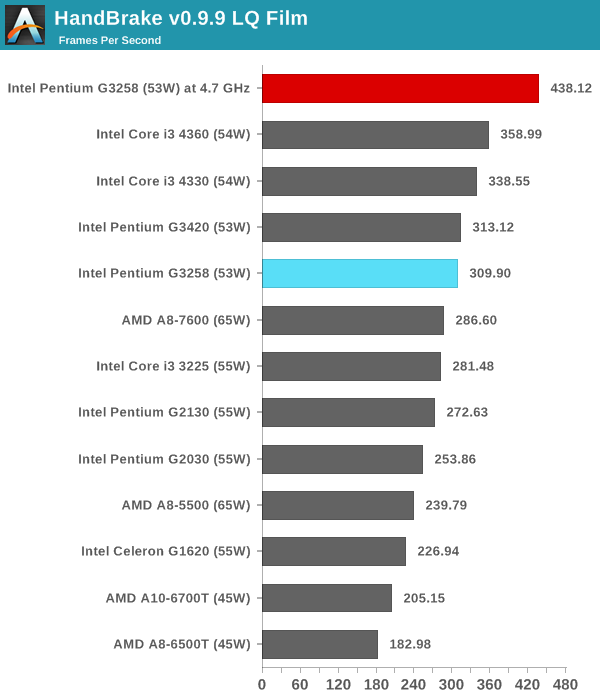
For low quality encoding, single threaded performance wins out over threads despite the extra multi-threading of i3 processors.
HandBrake, 4K60 Animation: link
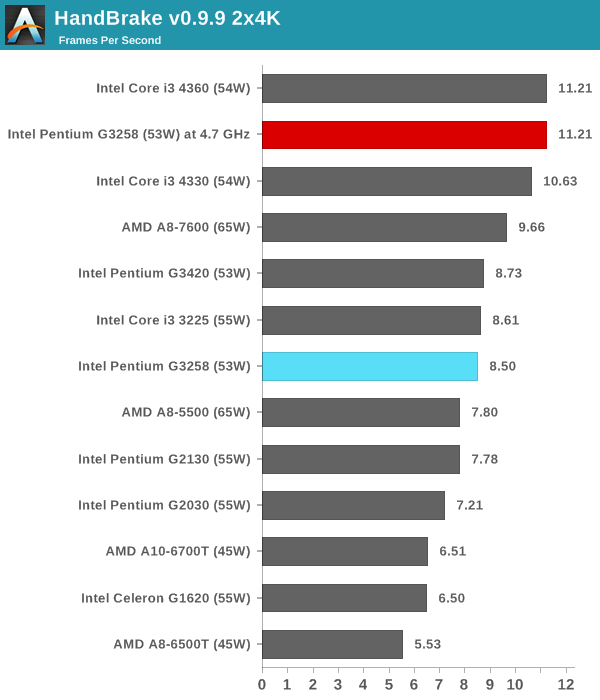
For larger frame sizes, the extra MHz of the overclock brings it on par with the i3-4360, although one might suggest spending the extra $40 for the i3 to ensure full stability.
Agisoft Photoscan – 2D to 3D Image Manipulation: link
Agisoft Photoscan creates 3D models from 2D images, a process which is very computationally expensive. The algorithm is split into four distinct phases, and different phases of the model reconstruction require either fast memory, fast IPC, more cores, or even OpenCL compute devices to hand. Agisoft supplied us with a special version of the software to script the process, where we take 50 images of a stately home and convert it into a medium quality model. This benchmark typically takes around 15-20 minutes on a high end PC on the CPU alone, with GPUs reducing the time.
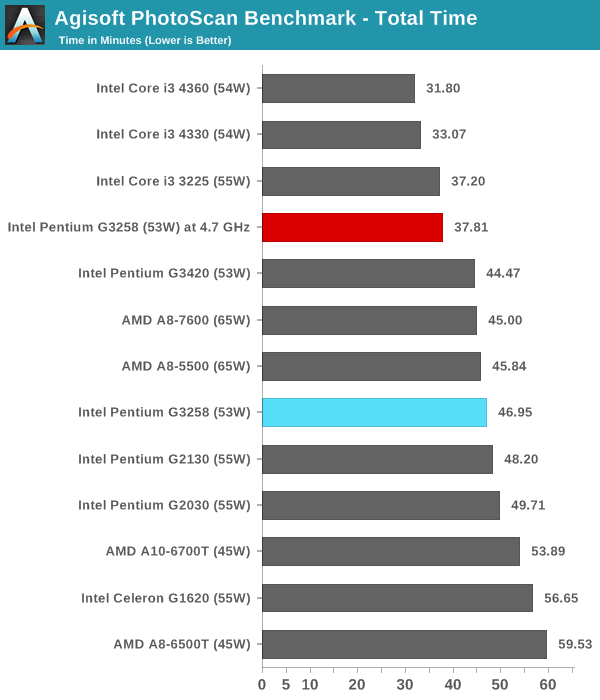
Dolphin Benchmark: link
Many emulators are often bound by single thread CPU performance, and general reports tended to suggest that Haswell provided a significant boost to emulator performance. This benchmark runs a Wii program that raytraces a complex 3D scene inside the Dolphin Wii emulator. Performance on this benchmark is a good proxy of the speed of Dolphin CPU emulation, which is an intensive single core task using most aspects of a CPU. Results are given in minutes, where the Wii itself scores 17.53 minutes.
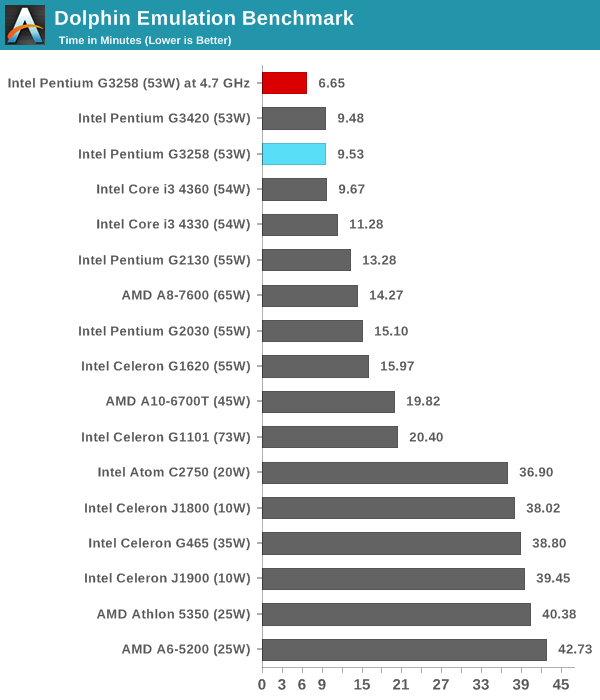
Dolphin is another example where Haswell combined with strong single threaded performance wins.
WinRAR 5.0.1: link
This test compresses a set of 2867 files across 320 folders totaling 1.52 GB in size – 95% of these files are small typical website files, and the rest (90% of the size) are small 30 second 720p videos.
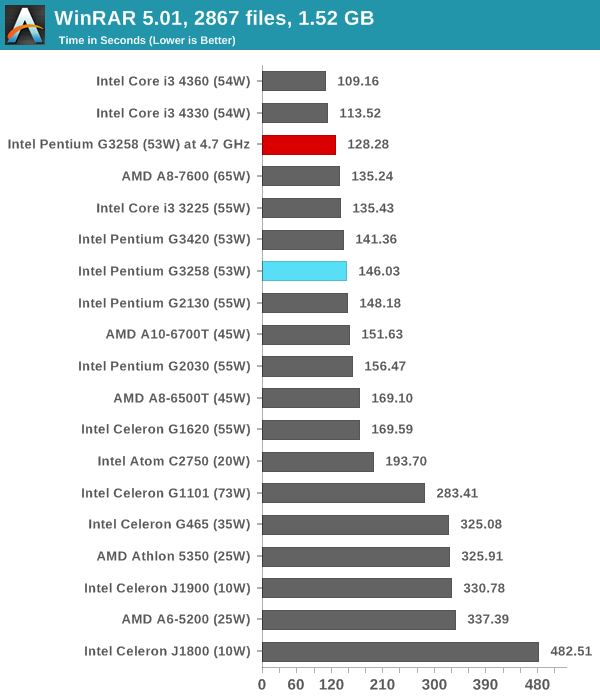
PCMark8 v2 OpenCL on IGP
A new addition to our CPU testing suite is PCMark8 v2, where we test the Work 2.0 and Creative 3.0 suites in OpenCL mode. As this test is new, we have not run it on many AMD systems yet and will do so as soon as we can.
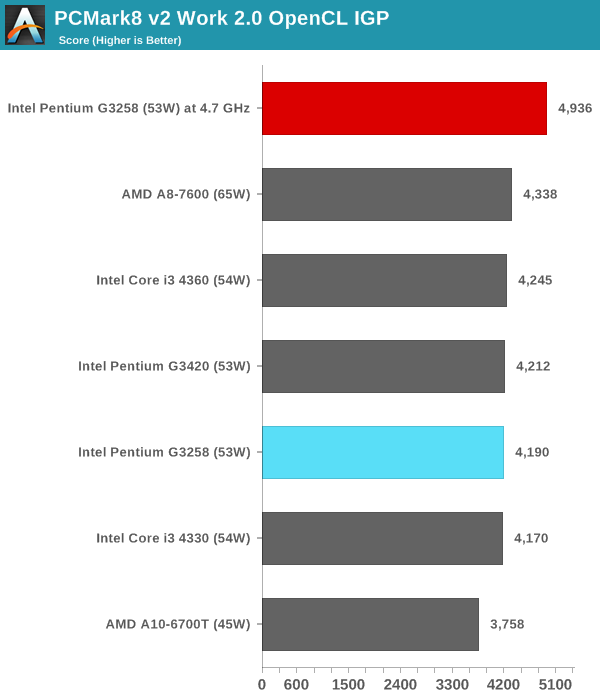
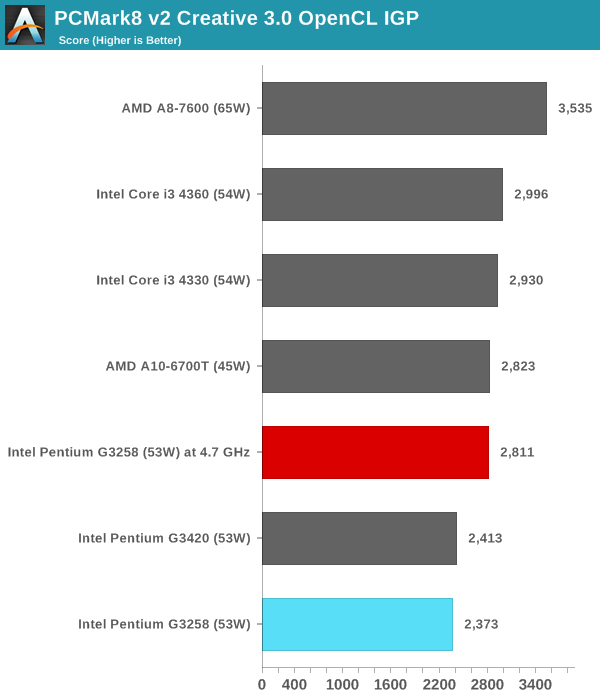
In both of our PCMark8 v2 results, overclocking the CPU gave a significant jump in performance. This would be down to the single threaded nature of parts of the benchmark, allowing web browsing and the snappyness of the system to be sped up.
Hybrid x265
Hybrid is a new benchmark, where we take a 4K 1500 frame video and convert it into an x265 format without audio. Results are given in frames per second.
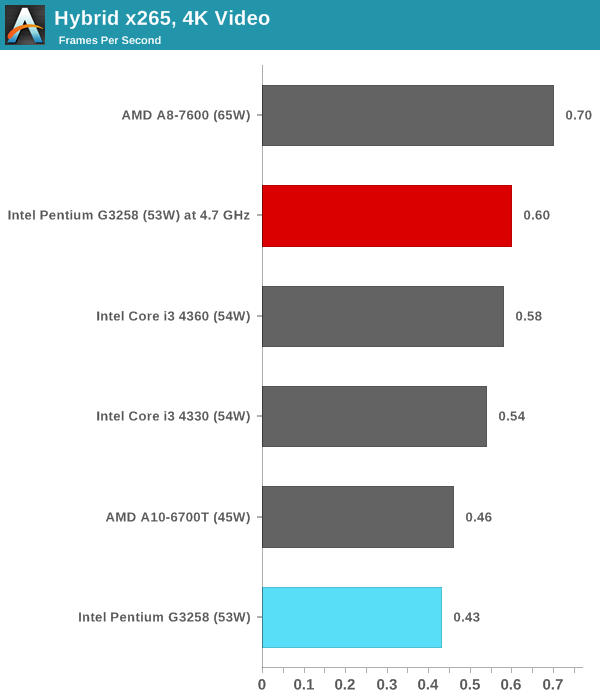
Almost an extra 50% performance for Hybrid x265 encoding.
Cinebench R15
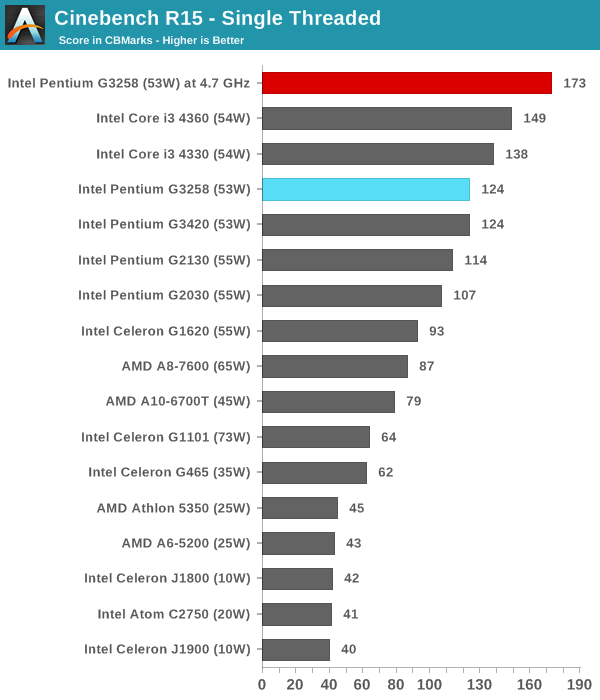
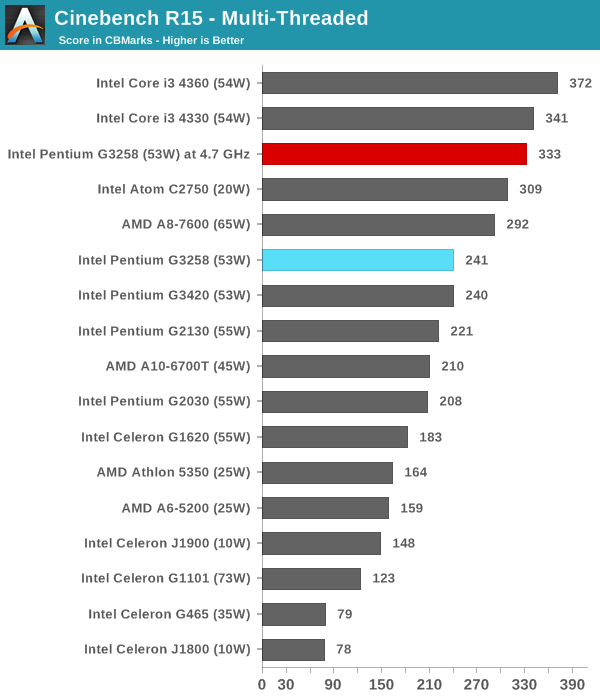
3D Particle Movement
3DPM is a self-penned benchmark, taking basic 3D movement algorithms used in Brownian Motion simulations and testing them for speed. High floating point performance, MHz and IPC wins in the single thread version, whereas the multithread version has to handle the threads and loves more cores.

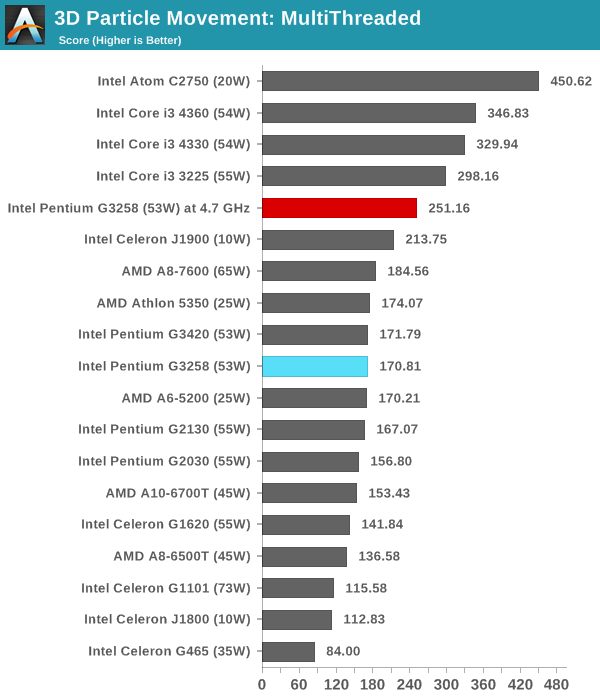
FastStone Image Viewer 4.9
FastStone is the program I use to perform quick or bulk actions on images, such as resizing, adjusting for color and cropping. In our test we take a series of 170 images in various sizes and formats and convert them all into 640x480 .gif files, maintaining the aspect ratio. FastStone does not use multithreading for this test, and results are given in seconds.
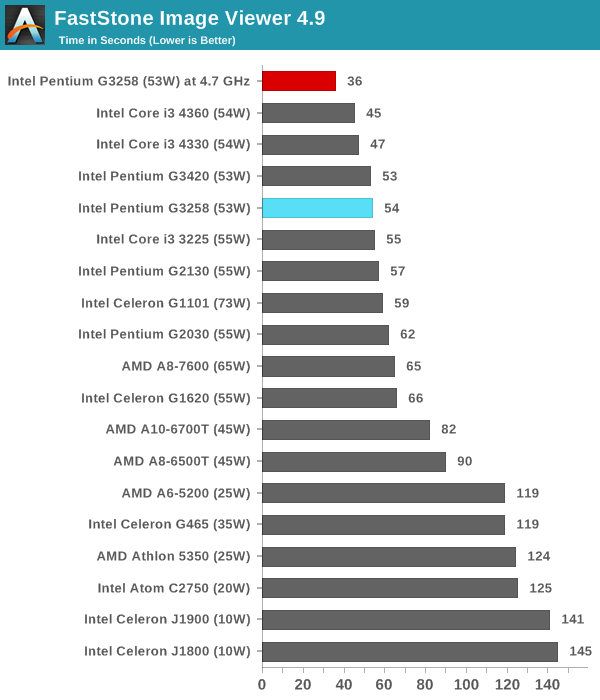
Web Benchmarks
On the lower end processors, general usability is a big factor of experience, especially as we move into the HTML5 era of web browsing. For our web benchmarks, we take four well known tests with Chrome 35 as a consistent browser.
Sunspider 1.0.2
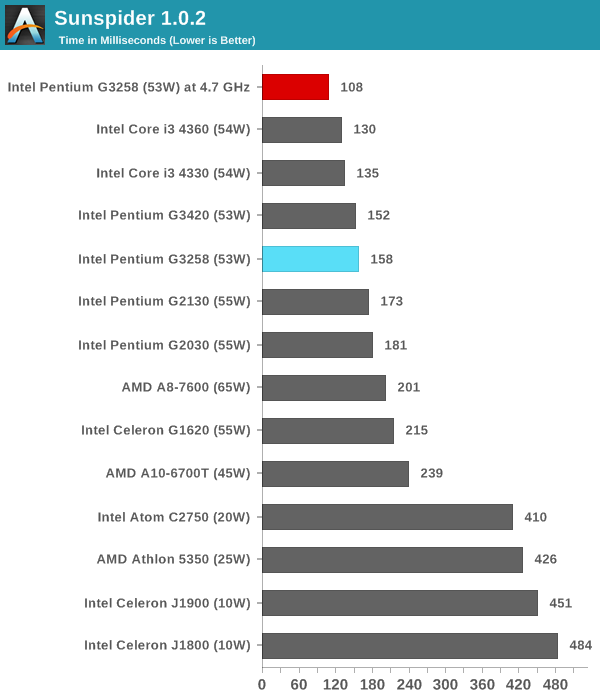
Mozilla Kraken 1.1
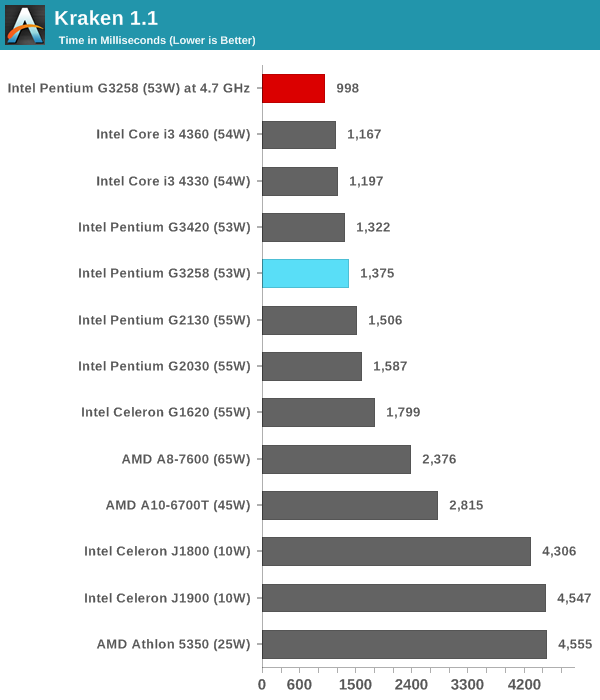
WebXPRT
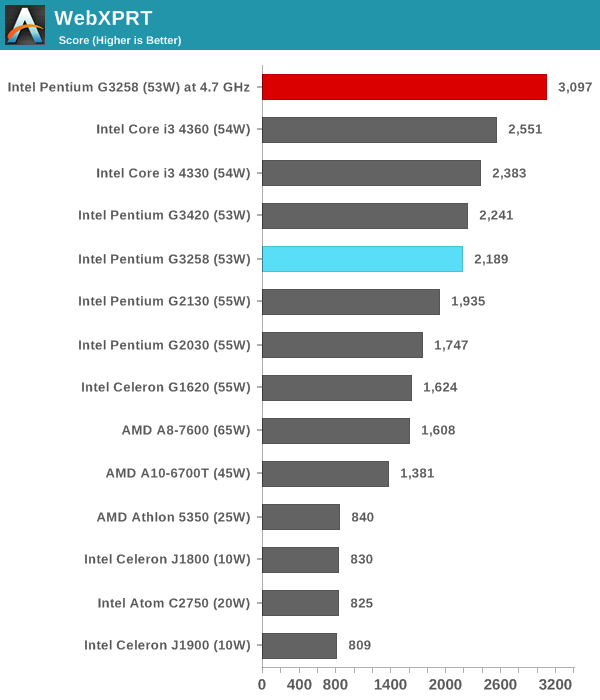
Google Octane v2
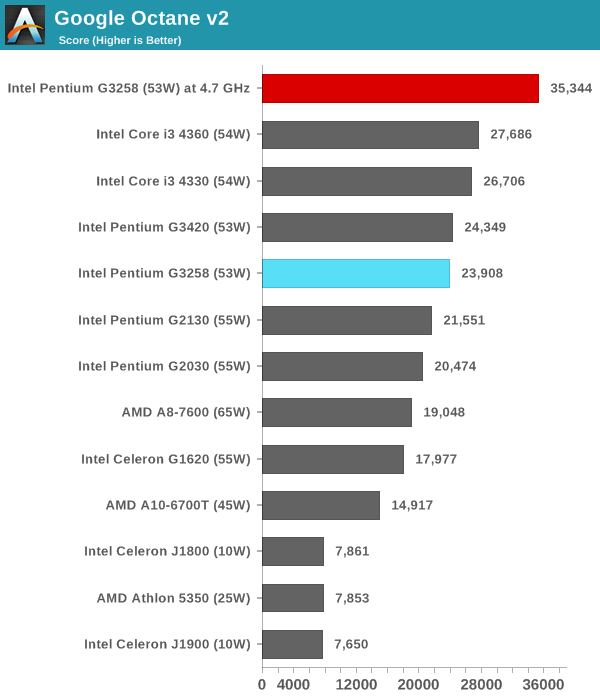
The usage model for an overclocked G3258 comes in highly single threaded environments. 4.7 GHz is nothing to be sniffed at, especially when it comes to web browsing or simple photo editing where it beats out more expensive processors. With multithreaded scenarios, it battles with the i3 depending on if the software can use hyperthreading to its full advantage. If the software can do that, then the i3 still wins out.










96 Comments
View All Comments
yhselp - Monday, July 14, 2014 - link
It would be interesting to see how a hypothetical i3-K would perform. Perhaps it's possible to test with an i7-K at around 4.5 GHz and two cores disabled?Also, it'd be interesting to see benchmarks with the type of games mentioned in the beginning of the review (and a low-mid range GPU) - DOTA 2, League of Legends, Counter-Strike: Global Offensive, popular MMORPGs, Minecraft, etc.
HanzNFranzen - Monday, July 14, 2014 - link
Yes, I agree totally. I think that the i3-K would the modern day version of the old Celerons because of the fact it is 4 threads. Ian did a great job in this article to show that we are past the point of '2 threads is enough' and a maxed out dual core isn't giving you the same extra free performance like over clocking did in the old days (because of todays low end of 4 thread processors). But as far as gaming is concerned, we have been to that point of '4 threads is enough' as seen by the i5 being the sweet spot for gaming for a couple years now. So a highly overclocked i3-K does fit into that scenario nicely. Perhaps Intel already knows this, and perhaps it fits a little TOO nicely that it would cut too far into i5 sales, and this is the reason they have not made one? So instead they chose to put out the Pentium-AE fully knowing it wouldn't cut into their i3 sales because the performance isn't there.Also, I second the request for a hypothetical i3-K test that yhselp proposed!
yhselp - Monday, July 14, 2014 - link
Indeed, but remember that we're talking about a specific set of games that aren't very demanding to begin with; in my mind, this Pentium-K or even a hypothetical i3-K would never be enough for proper high image quality gaming with the latest games, however, it might be very well-suited for DOTA/LoL/CS, etc. The source engine, especially with Valve games, is terribly single-threaded so I wouldn't be surprised if an OC'd G3258 actually pulls ahead of stock i3 under certain circumstances with these games. Unfortunately, that's one set of benchmarks we didn't get.eanazag - Monday, July 14, 2014 - link
The problem with using the i-7's and down clocking to simulate lower tier processors is that the L3 cache is still there at 8MB, where those lower tier processors are severely castrated in that department. You can get the memory simulated and thread counts can kind of be controlled.Samus - Monday, July 14, 2014 - link
Just makes no sense. Overclocking is generally targeted at gamers and data crunchers. The Pentium AE does neither because it has no hyper threading and no AES. Even at 5GHz this thing couldn't touch a stock i3 in gaming or data crunching. The salt on the wound is the i3 can be had for $40 more, and you can SAVE $40 opting for a non-overclocking motherboard chipset.So basically for the same price, you can get an i3 platform with superior performance. This thing is literally just for "fun" but once reality sets in and you consider the facts, fun turns to regret.
I feel as if this chip is simply a delivery platform for high-end Intel chipsets to people who would otherwise get an H-series.
If you want a real overclocking platform, just spend the extra $100 and get an i5-4690k. If you want a quality gaming CPU or need modern multithreaded performance (and practically all apps/games are multithreaded now, BF4 practically requires quadcore) get an i3 for $40 more and save $40 on the fancy motherboard, breaking even compared to a Pentium AE.
formulav8 - Monday, July 14, 2014 - link
Typical Intel gimmicks and some its seems think they are doing us a favor or whatever.I was actually quite interested with and tinkering with a Pentium K until it was clear Intel makes you by a stinking Z board. Yeah Intel, a real Pentium celebration, for you.
Computer Bottleneck - Monday, July 14, 2014 - link
You don't need a Z board to overclock Pentium G3258.Also Intel supplies a beefy 95 watt cooler with Pentium G3258.....so no need buy aftermarket HSF unless a person is trying to squeeze out the last 200 Mhz of the overclock.
Samus - Monday, July 14, 2014 - link
Since only Z boards are firmware-ready for the G3258, unless you have a first-gen Haswell lying around along with a 80-series "new stepping" H81 or better, your stuck with a Z97 or "compatible" H97 (again, read firmware update required.)All the launch boards/combo's for G3258 aren't Z97-chipsets by mistake. It is essentially required at this point. It will change as time goes on, but that doesn't change the fact you are better off with an i3+H81 for the SAME PRICE as a G3258+Z97. The G3258 is such a weak multithreaded performer (having two physical cores with no hyper-threading) that if you are looking to spend that little on some fun, you're actually just better off with an AMD platform.
And the cooler is still shit. Nobody has had their G3258 run for 24 hours at STOCK speed without throttling. STOCK. How do you think 1" of tiny fins and a 1200RPM fan is going to dissipate 50w of heat? Notebook heatpipes are more effective and they only need to dissipate 15-35w of heat.
Anybody who actually buys this platform is misinformed. The writing is on the wall. No reviewers can morally recommend this chip unless you just like the "fun" of overclocking. Beyond that, its a bad investment. An i3 platform with a more basic chipset will be faster for the same price, or less.
Computer Bottleneck - Monday, July 14, 2014 - link
Why don't you like the stock 3258 cooler? It is the same cooler that cools a Haswell i7 quad core, yet the 3258 even when OC consumes only a modest amount of extra power (see system power consumption chart on page 1 of this review).Zap - Tuesday, July 15, 2014 - link
"And the cooler is still shit. Nobody has had their G3258 run for 24 hours at STOCK speed without throttling. STOCK."I see plenty of reports in the forums of people using the STOCK cooler that came with the G3258 to hit 4.5GHz running 100% load in the 60-70°C temperature range, without being super noisy either. These are first-hand reports from those who have actually tried it.
Here is one such thread:
http://forums.anandtech.com/showthread.php?t=23910...
Also, cheap non-Z motherboards can overclock this CPU:
http://forums.anandtech.com/showthread.php?t=23899...
(Thanks Computer Bottleneck for the links)
But you go believe what you want, and if you have proof please post links. Potentially there is a huge conspiracy with a bunch of people posting that the stock cooler works fine when it really doesn't. I do not discount that possibility, however unlikely.